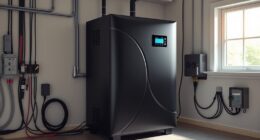Optimize your house orientation for energy efficiency by facing it towards the sun's path. Aligning your house in this way helps maximize solar gains and reduces heating costs. Consider a longitudinal east-west orientation to lessen energy needs or a true south orientation for peak efficiency. Take advantage of south-facing windows for natural light and heat. Strategic shading with trees can help balance energy usage. By optimizing your home's orientation, you can save significantly on heating expenses. Learn more about building orientation fundamentals, heat gain strategies, and innovative design considerations for maximum efficiency.
Key Takeaways
- Orient house longitudinally east-west for reduced energy needs.
- Maximize solar gains with true south orientation.
- Strategic window placement enhances energy efficiency.
- Utilize south-facing windows for natural sunlight.
- Align floor plan towards the Sun for heat gain.
Building Location and Orientation
Choosing the right location and orientation for your home is vital for maximizing energy efficiency. Building orientation plays a pivotal role in determining how much solar gain your home receives, impacting its overall energy efficiency.
Homes oriented longitudinally east-west tend to require less energy for heating and cooling. This orientation allows for maximum solar gains from the south during the colder winter months, helping to naturally warm the interior spaces. By strategically placing your home to optimize sun exposure, you can take advantage of passive solar heating, reducing the need for artificial heating systems and ultimately lowering your utility bills.
Additionally, proper building orientation not only improves energy efficiency but also enhances the comfort level inside your home by ensuring ample natural light throughout the day. To achieve optimum energy efficiency, it's crucial to find the true south for accurate orientation and harness the benefits of passive solar design.
Sun's Impact on Building Design

When considering the Sun's impact on building design, it's essential to understand how solar position affects passive solar gains throughout the year.
By orienting your home towards the Sun, you can enjoy lower utility bills and increased comfort, thanks to maximizing solar gains and minimizing heat losses.
The Earth's axis causes the Sun's position in the sky to shift with the seasons, emphasizing the importance of longitudinal orientation for energy efficiency.
Solar Position Effects
Optimizing a building's orientation towards the Sun is essential for harnessing maximum energy efficiency benefits in design. The solar position, influenced by the Earth's axis tilt, directly impacts how buildings receive sunlight and can lead to significant energy savings.
Understanding the Sun's position throughout the year is vital for maximizing passive solar gains in building design. Homes should ideally be oriented with an east-west ridgeline to optimize exposure to the Sun.
By reorienting houses towards the Sun, substantial energy efficiency benefits can be achieved, resulting in cost savings of 10% to 40% on heating costs. Proper orientation plays a key role in enhancing energy efficiency and reducing reliance on artificial heating sources.
Orientation Benefits
A strategic alignment towards the Sun enhances building design by maximizing natural light and reducing dependence on artificial lighting. Proper building alignment can significantly impact energy efficiency in a home. By positioning windows and the layout to take advantage of the Sun's path, you can decrease the reliance on artificial lighting during the day. This not only decreases energy consumption but also creates a more comfortable and welcoming living space.
Additionally, aligning your home towards the Sun can lead to substantial savings on heating costs, as passive solar gains help to naturally heat the building. During the summer, proper alignment can also help to minimize heat gain, reducing the need for excessive air conditioning. Understanding the Sun's impact on building design is essential for optimizing energy efficiency and creating a sustainable living environment.
Building Design Impact
Positioning your house to align with the Sun's path can have a significant impact on the design and energy efficiency of the building. Proper building orientation towards the Sun's path is crucial for maximizing passive solar gains and energy efficiency. The Sun's varying positions throughout the year influence solar gain and heat distribution within the house. By orienting your house towards the Sun, you can enjoy energy savings of 10-40% on home heating costs. Rectangular houses, in particular, benefit from an east-west ridgeline orientation to optimize sun exposure and heating benefits. Re-orienting your home for optimal sun exposure can result in substantial reductions in heating costs, potentially up to 40%.
| Building Design | Impact on Energy Efficiency |
|---|---|
| Proper Orientation | Maximizes passive solar gains |
| East-West Layout | Optimizes sun exposure |
| Re-Orientation | Significant reduction in heating costs |
Design Practices for Efficiency

To optimize your home's energy efficiency, consider a solar-optimized layout and strategic placement of windows for maximum sunlight utilization.
Orienting your home towards the Sun can help reduce energy consumption and lower utility costs.
Solar-Optimized Home Layout
Optimize your home layout for solar efficiency by orienting it longitudinally to maximize solar gains and minimize heat losses. Positioning your home along the east-west axis enhances its energy efficiency by allowing the structure to benefit from the sun's natural light and passive solar heating.
When designing your floor plan, make sure that the house faces south to capture the most solar heat. Additionally, incorporating proper ventilation systems and strategic placement of thermal mass elements can further optimize your home's energy performance.
To regulate indoor temperatures effectively, consider planting shade trees strategically around your property. These trees can provide natural shading in different seasons, reducing the need for excessive cooling measures during the warmer months.
Installing windows on the south-facing wall can also serve as a heat source, contributing to the overall energy efficiency of your home. By implementing these solar-optimized design practices, you can create a comfortable and sustainable living environment while minimizing your energy consumption.
Efficient Sunlight Placement
Enhance the energy efficiency of your home by strategically placing windows on the south-facing wall to harness natural sunlight as a heat source. Proper house orientation can lead to significant energy savings, with potential reductions of 10-40% on heating costs.
By maximizing natural lighting through solar-optimal positioning, you not only save on electricity but also create a more comfortable living environment.
In addition to south-facing windows, consider strategic tree planting to provide shading during different seasons, further enhancing energy efficiency. This approach helps regulate indoor temperatures, reducing the need for excessive heating or cooling.
Efficient sunlight placement is a key aspect of house orientation that directly impacts your energy consumption. By making intentional design choices to leverage solar energy, you can lower your utility bills and decrease your environmental footprint.
Prioritize natural lighting and heat from the sun to optimize your home's energy performance while ensuring a sustainable and cost-effective living space.
Home Longitudinal Orientation

For the most energy efficiency, consider orienting your home longitudinally with the length running east-west and width north-south. This setup maximizes solar gains from the south during colder months, reducing heat losses due to wind on the eastern and western sides of the house.
As a result, you can enjoy reduced utility bills and enhanced comfort throughout the year. Longitudinal orientation also allows for efficient passive solar heating, decreasing the need for artificial heating and lowering overall energy consumption.
True South Orientation

Positioning your home towards actual south is vital for maximizing solar gain and enhancing energy efficiency. Actual south orientation ensures that your home receives the maximum amount of sunlight throughout the day, which is essential for passive solar heating. By aligning your home's short axis towards actual south, you can maximize energy efficiency and reduce heating costs.
Accurate placement of windows and solar panels is key to harnessing the benefits of actual south orientation. Windows strategically positioned on the south side allow for natural light and heat to enter the home, reducing the need for artificial lighting and heating.
Solar panels installed facing actual south can generate more electricity due to increased sun exposure, leading to optimal energy savings.
Maximizing Solar Gains

To maximize solar gains in your home, consider orienting it longitudinally to maximize sunlight exposure during colder months. This strategic house orientation can lead to significant energy savings by reducing heating costs and enhancing overall energy efficiency.
Here are three key practices to enhance solar gains and improve energy efficiency in your home:
- Utilize the south-facing wall: Installing windows on the south-facing wall allows for best sunlight penetration, acting as a natural heat source during the winter months and reducing the need for artificial heating.
- Strategic shading: Planting trees strategically around your home can provide shading in the summer to reduce cooling needs while allowing sunlight to enter during the winter, striking a balance for energy efficiency throughout the year.
- Maximize natural lighting: Properly orienting your floor plan towards the Sun not only enhances solar gains but also minimizes the need for artificial lighting, further decreasing energy consumption and costs.
Building Orientation Fundamentals

Enhancing building orientation is vital for maximizing energy efficiency and overall property value. When considering the orientation for optimum energy efficiency, aligning your house for natural light and passive solar construction can lead to reduced cooling costs and more energy-efficient living spaces.
By understanding your local climate and the principles of thermal performance, you can markedly impact your indoor comfort and lower your energy bills.
Proper building orientation plays an integral role in passive solar construction. This approach utilizes the sun's energy for heating and lighting, reducing the need for mechanical heating and cooling systems. By strategically placing windows, shading elements, and thermal mass, you can optimize your home's energy efficiency.
Making informed decisions about your building's orientation based on mathematical models can help you save between 10% and 40% on heating costs. This cost-effective strategy not only benefits your wallet but also contributes to a more sustainable and environmentally conscious lifestyle.
Heat Gain Strategies

Maximizing heat gain in your home involves strategic placement of elements like windows, trees, and outdoor spaces to optimize sunlight absorption and energy efficiency.
To achieve ideal heat gain, consider the following strategies:
- Sun Orientation: Orient your floor plans towards the Sun to increase heat gain during colder months effectively.
- South-Facing Windows: Installing windows on the southern wall serves as a natural heat source, allowing for better energy efficiency and warmth inside the house.
- Natural Elements: Strategically placing patios, decks, and trees on the south side of your home can help maximize sunlight exposure for heat gain while also providing shade when necessary.
Innovative Design Considerations

Incorporating innovative design elements can revolutionize the energy efficiency of your home. When considering energy performance, maximizing solar energy is crucial. Homes designed to follow the Sun's path can optimize solar energy efficiency. Adjusting the east-west ridgeline orientation can significantly enhance this efficiency further. Moreover, the placement of driveways and parking lots around the house plays a vital role in managing heat buildup. Strategic positioning can prevent excessive heat from affecting the home's temperature regulation. Custom glass solutions are another key aspect to consider. These solutions can minimize reflection and increase natural sunlight penetration, leading to improved energy performance.
| Innovative Design Considerations | |
|---|---|
| Maximize solar energy | Follow the Sun's path for optimal solar energy efficiency |
| East-west ridgeline orientation | Adjust orientation to enhance solar energy utilization |
| Driveways and parking lots | Proper placement to mitigate heat buildup around the house |
| Custom glass solutions | Minimize reflection and maximize natural sunlight penetration |
Frequently Asked Questions
What Is the Best Orientation for a House for Energy Efficiency?
For energy efficiency, the best orientation for a house varies by climate. South-facing captures sunlight for heating in colder regions, while north-facing suits warmer areas to prevent overheating. East and west orientations offer morning and afternoon light, respectively.
How Does Building Orientation Affect Energy Efficiency?
When you position your home to face the sun, you harness free heat in winter, slashing heating bills by 10-40%. Proper orientation reduces costs by up to 40%, optimizing energy efficiency year-round.
What Is the Best Way to Orient a House?
To orient a house efficiently, align its length east-west and width north-south. This maximizes solar gains from the south in colder months and minimizes heat losses from wind. Proper orientation also enhances natural lighting and reduces artificial lighting needs.
What Is the Best Direction for a House to Face?
Face your house south for maximum solar gain in colder climates. South-facing homes save 10-40% on heating costs due to increased sunlight exposure. East gets morning sun, west gets afternoon sun, and north minimizes heat gain in warmer climates.
How Can House Orientation Impact the Efficiency of Wind Turbines and Solar Panels?
When considering maximizing renewable energy with wind turbine and solar panel combination, house orientation becomes crucial. Orienting the house to face the prevailing wind direction can increase the efficiency of wind turbines. In addition, positioning the house to receive maximum sunlight can optimize the performance of solar panels.
How Does House Orientation Impact the Effectiveness of Wind Turbine Upgrades?
The orientation of a house can significantly impact the effectiveness of wind turbine blade upgrades. Houses with optimal orientation can maximize the benefits of upgraded wind turbines by capturing maximum wind energy. Proper positioning of wind turbines in relation to the house can enhance their performance and efficiency.
Conclusion
Now that you understand the importance of optimizing your house orientation for energy efficiency, envision this: a home bathed in natural sunlight, keeping you warm and comfortable all year round.
By maximizing solar gains and implementing innovative design strategies, you can notably reduce your energy consumption and environmental impact.
So, when considering your next building project, remember to prioritize orientation for a brighter, more sustainable future.









